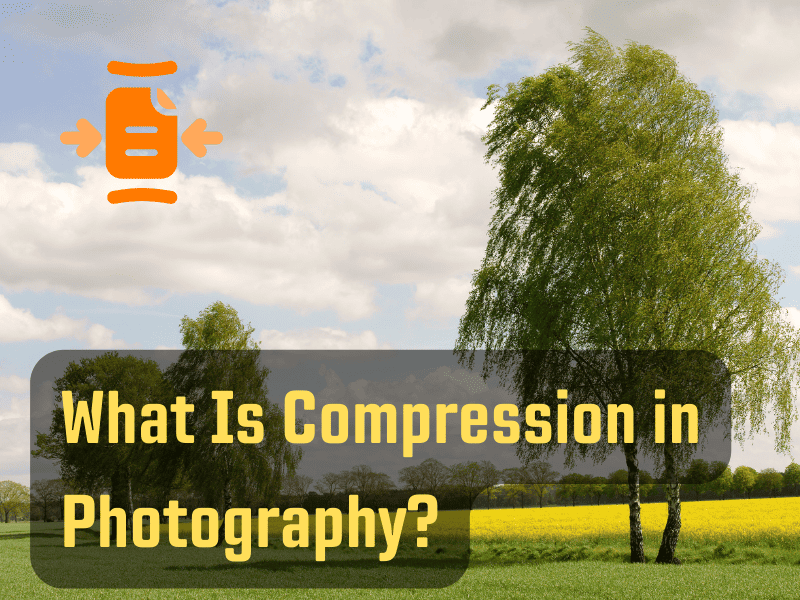Table of Contents
The Dual Faces of Compression
Before diving deep into the intricacies of photography compression, it’s pivotal to establish that there are two predominant forms of compression in the photographic world: image compression and visual (or perspective) compression.
Image Compression: When Bytes and Pixels Meet
Image compression is the process of reducing the file size of an image, often for storage or sharing purposes.
Lossless vs. Lossy Compression
There are two primary ways in which image compression is executed:
- Lossless Compression: Retains all the original data of the image, ensuring no loss in quality. Common formats include PNG and certain TIFF files.
- Lossy Compression: Some data is discarded, leading to decreased image quality. JPEG is a common format that uses this type of compression.
| Compression Type | Quality Retention | Common Formats |
|---|---|---|
| Lossless | Full Quality | PNG, TIFF |
| Lossy | Reduced Quality | JPEG |
Why Does It Matter?
One might wonder, “If lossless maintains quality, why use lossy?” The answer lies in necessity and compromise. Lossy formats like JPEG are popular because they significantly reduce file sizes, making them ideal for web use. However, lossless formats ensure original data remains intact when editing or archiving images.
The Consequences of Over Compression
The Ugly Face of Artifacting
Artifacting is a term that’s all too familiar to photographers, especially those who’ve pushed the boundaries of image compression. As an image is compressed repeatedly or too aggressively, undesirable patterns and distortions, known as artifacts, can emerge. They can manifest as:
- Blocky areas, especially in parts of the image with subtle color transitions.
- Ringing or halos around high-contrast boundaries.
- Loss of sharpness and detail.
The Impact on Post-processing
Over-compressed images can pose significant challenges in post-processing. For instance, pulling details from the shadows or correcting colors can lead to exaggerated noise or other anomalies. As a rule of thumb, always work with the highest quality images during post-processing and only compress for the final output.
Visual or Perspective Compression: A Game of Lenses and Distance
When photographers refer to visual compression, they’re delving into a concept that pertains to the appearance of depth and spatial relationships in a photograph.
The Science Behind It
This compression isn’t about file size but the juxtaposition of objects in an image. When you use a telephoto lens, objects in the foreground and background appear closer together than in real life. This “compression” of space is purely a visual effect created by the lens and your position relative to the subject.
Consider this analogy: if you’re standing on a train track (safely, in a hypothetical world) and looking down the rails with your naked eye, the tracks seem to converge in the distance. Now, if you were to look through a long telephoto lens focused on a distant point on those same tracks, the rails would appear more parallel, as if the distance between them has been “compressed.”
Factors Influencing Visual Compression
- Focal Length: Longer focal lengths (like 200mm or 300mm) intensify this compression effect. On the other hand, wide-angle lenses (like 24mm or 35mm) tend to exaggerate distances, making objects appear farther apart.
- Distance from Subject: Even with a telephoto lens, the compression effect is less pronounced if you’re close to your subject. However, as you move away and zoom in, the effect becomes more evident.
| Focal Length | Effect on Depth Perception |
|---|---|
| Wide-angle | Exaggerates Distances |
| Telephoto | Compresses Distances |
The Artistic Implications of Visual Compression
Storytelling Through Compression
Visual compression isn’t just a technical consequence of lens choice; it’s also a powerful storytelling tool. By manipulating the perception of distance, photographers can:
- Create intimacy in a scene by bringing distant elements closer together.
- Emphasize the subject by reducing the apparent distance between foreground and background, making them more cohesive.
- Alter the viewer’s sense of scale, making faraway mountains appear more imposing or a distant crowd appear closer and more significant.
Compression in Motion: Videography’s Tale
Photography isn’t the only field wrestling with compression. Videographers, too, must grapple with compression, both in terms of data and visuals.
Data Compression in Video
Just like with still images, videos can undergo lossy and lossless compression. But the stakes can be higher. Compress a video too much, and you may end up with:
- Motion artifacts.
- Muddied colors.
- Loss of detail in crucial frames.
Temporal Compression in Videography
There’s also the concept of temporal compression in motion pictures and videos. This doesn’t involve reducing file sizes but rather playing with the perception of time. Slow-motion shots stretch moments in time, while time-lapses compress long durations into mere seconds. This form of ‘compression’ offers videographers another dimension of storytelling, enabling them to warp time for dramatic or aesthetic effects.
Composition and Compression: A Dance of Elements
Comprehending visual compression can dramatically change a photographer’s approach to composition. With the knowledge of how distances are perceived differently through varying lenses, photographers can play with:
- Foreground and background relationships.
- Layering elements in a scene.
- Creating depth even in seemingly ‘flat’ landscapes.
The Intersection of Image and Visual Compression
Interestingly, these two forms of compression can intersect. Selecting the right image compression format becomes crucial when editing a photograph, especially one with perspective compression. The nuances of the depth created by visual compression might be lost if a lossy compression method reduces image quality significantly.
In Summary: Clarifying the Compression Conundrum
- Image Compression relates to reducing file sizes by retaining all original data (lossless) or discarding some (lossy).
- Visual Compression is about the perception of depth in an image, influenced by lens choice and the photographer’s position.
By understanding these distinctions, photographers can make informed choices in the field while shooting and during post-processing, ensuring their artistic vision is perfectly captured and shared.
